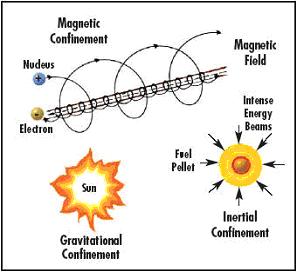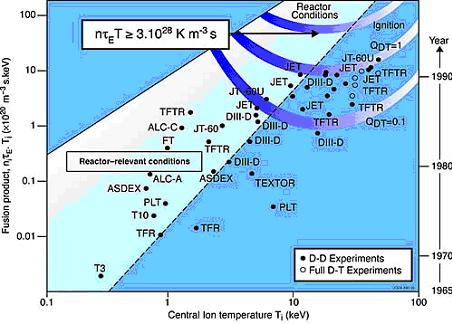l Principles of Fusion Power
When two atomic nuclei are forced into close proximity, nuclear attraction force overcomes the electrostatic repellent force (Coulomb force), and the two nuclei fuse into one nucleus thereby releases fusion energy. Nuclei normally repel one another because of the electrostatic repulsion arising from the charges they carry. In order to fuse, these nuclei have to be given sufficient kinetic energy (i.e. velocity) to overcome their mutual repulsion when they collide. This can only be achieved by heating the D-T fuel to very high temperatures in the range of 100 –150 million degrees centigrade.
The difficulty in producing fusion energy has been to develop a device which can heat the deuterium-tritium fuel to a sufficiently high temperature and then confine it for a long enough time so that more energy is released through fusion reactions than is used for heating. At such temperatures the gaseous fuel is completely ionized, forming a “plasma” comprising of a hot mixture of clouds of positive ions and negative electrons, but is overall electrically neutral. The plasma must not be allowed to come into contact with the walls of the reaction container (vessel), since some of the surface layer of the wall would evaporate and the plasma would be immediately polluted and cooled, losing the conditions for fusion reactions to occur.
In Star and Sun, gravitational force creates the necessary conditions for fusion to occur. The more practical approaches on earth are magnetic confinement, where a strong magnetic field holds the ionized atoms together while they are heated by microwaves or other energy sources, and inertial confinement, where a tiny pellet of frozen hydrogen is compressed and heated by intense radiation, such as a laser beam, so quickly that fusion occurs before the atoms can fly apart. In other words, magnetic fusion is like a continuously burning nuclear furnace whereas laser fusion is more like an internal combustion engine where the energy is delivered in bursts.

Sources: http://www.ofes.fusion.doe.gov/whatisfusion.shtml
The fuel plasma needs to reach a high enough temperature to be ‘ignited’. In addition, three parameters (plasma temperature, density and confinement time) need to be simultaneously achieved for sustained fusion to occur. The product of these is called the fusion (or triple) product and the corresponding threshold for D-T fusion to occur is called Lawson Criterion. Attaining conditions to satisfy the Lawson criterion ensures the plasma exceeds ‘breakeven’, i.e., the point where the fusion power released exceeds the power required to heat and sustain the plasma. Substantial progress in magnetic confinement has been made. Near “breakeven” state has been achieved as shown in the diagram below.

Source: http://www.jet.efda.org/pages/multimedia/yop/dec05-jg04-480-2c.jpg